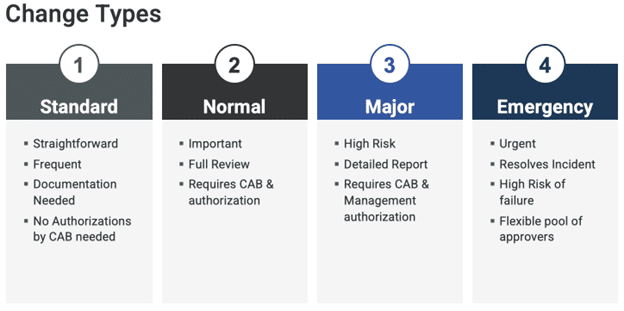Modernizing Your Change Process
November 3, 2022
Not all changes are the same, and even if a change looks the same, it is not because the underlying conditions of the systems involved have changed. In reality, change is a constant, and change is constant.
“change is the only constant in life.” – Heraclitus
Not all changes are the same, and even if a change looks the same, it is not because the underlying conditions of the systems involved have changed. In reality, change is a constant, and change is constant.
Change management is an IT practice designed to minimize disruptions to IT services while making changes to critical systems and services. Change management practices are designed to reduce incidents and meet regulatory standards. Since a “change” is defined as adding, modifying, or removing anything that could have a direct or indirect effect on services, there is a lot that the IT Community has to manage.
The practices ensure efficient and prompt handling of IT infrastructure and code changes. Whether rolling out new services, managing existing ones, or resolving problems in code, modern change management approaches break down silos, provide context and transparency, avoid bottlenecks, and minimize risk.
As the consumerization of IT proliferates with Remote Work, supply chain issues, and the like, the scope and scale of changes that IT organizations face will continue to skyrocket. How do you keep up?
Automation is an obvious answer, but it is merely one element in the Modern Change Process. Some other factors and opportunities can dramatically increase IT’s ability to handle the tidal wave of change.
Let’s look at some steps toward modernizing your Change Process.
Change as an experience
Change management is known for being arduous, process-heavy, and cumbersome – but the truth is that a modern change process reduces incidents while keeping processes agile and minimizing work disruption.
By viewing change as the experience, not an event, change becomes the end-to-end experience (think of the maps app on your phone, updating route information as you drive), then changes become standard, setting them up for automation, validation, and expediting.
Understand your organization’s risk tolerance and regulatory obligations
No two organizations are the same, even in the same industry. Some institutions may embrace cloud technologies, while others do not. Evaluating your organization’s risk profile and regulatory requirements is key as you look to modernize your change process and can help you understand and achieve your goals without a tremendous uplift.
When regulation is involved, it’s no longer a question of how much downtime your system can risk before losing business or the cost of resources if you have to fix a problem. It’s a non-negotiable set of rules. You will have certain approvals required. You will segregate duties. Regulations like SOX and GDPR make certain activities non-negotiable.
Simplify and automate change processes where ever possible
Traditional change processes create much extra work, and no one wants that. Keep approvals to a minimum where possible. Apply technology and tooling that integrate into existing processes and applications to reduce data entry and automate wherever possible. Simple change processes are easier to automate. The simpler you make the process, the easier it will be to get teams on board and keep them on track.
Reinvent the Change Advisory Board (CAB)
Most organizations started IT Management with ITIL. ITIL Defined change types and matched processes to manage the risk based on the change. Of course, the world has changed quite a bit since the initial popular adoption of ITIL; as such, let’s look at their most recent guidance on Change Type. Whether you use ITIL, have gone full DevOps, use another framework or anything in between, we can use these to level-set some of the guidance presented today.
Here we see a couple of keywords…Change Authority – These are approvers… and the CAB. The message is clear if we can modernize our change process and move our changes toward Standard and Normal, we move through the process faster while still meeting the objectives of Change Management as a practice. The goal, of course, would be to craft our change process to shift as many of our changes – which could be upward of 70% – to Standard. This sets the stage for later Automation. Embrace practices that make standard change the new normal change.
Look at governance frameworks such as ITIL or DevOps as guides, not rigid rules
If you ask ten people “what is <fill in your framework here>, you will likely get ten different answers. Your organization is unique and you should have the freedom to tailor the processes to match those unique needs. If you think about it, DevOps exists because ITIL did not fit.
Adopt Automated Change Validation
Someone once said, “Practice does NOT make perfect; perfect practice makes perfect.” The adage highlights that you drill into bad habits if you practice them wrong.
If I co-opt that ideal for Change Management,” Automation does not make acceleration, Automated Validation makes acceleration.”
Automation can be an accelerator of disaster… taking a simple misconfiguration, isolated in a blast radius by the time it takes to make a change manually and a bad result to get reported, and scaling that minor mistake to epic proportions. Automation, without validation, is a long walk off of a short pier.
Let’s add that current manual validation… UAT Testing is bothersome and time-consuming, the opposite of what you are trying to accomplish in getting changes automated and implemented as quickly and cleanly as possible because there are dozens more behind it.
The last item on our list is Automated Change Validation to match your modern (automated) change management process.
Putting the Pieces Together
Using these guidelines with automation will jumpstart your efforts to modernize your change process, but your change process will only be able to scale to a point where automation introduces too much risk. As you modernize your change process to keep pace with the tidal wave of changes, be sure to match that pace with checks and balances and ensure you do not automate yourself into a mess.
The Login Enterprise Platform helps you get ahead of the chaos and modernize your existing change processes. Using workflows that mimic real-user behavior and business processes, automated tests consisting of one or more workflows can be run throughout the entire lifecycle of change. Start with a single endpoint to rapidly determine impact, then build up to multiple changes at a grander scale before approving the release into production. After release, you can run the same tests in production to verify performance remains as expected.
Watch my recent session on Modernizing Your Change Processes on-demand to learn how to streamline change sets in faster batches, gain insights without waiting for end-user champions, and speed up your change windows.


